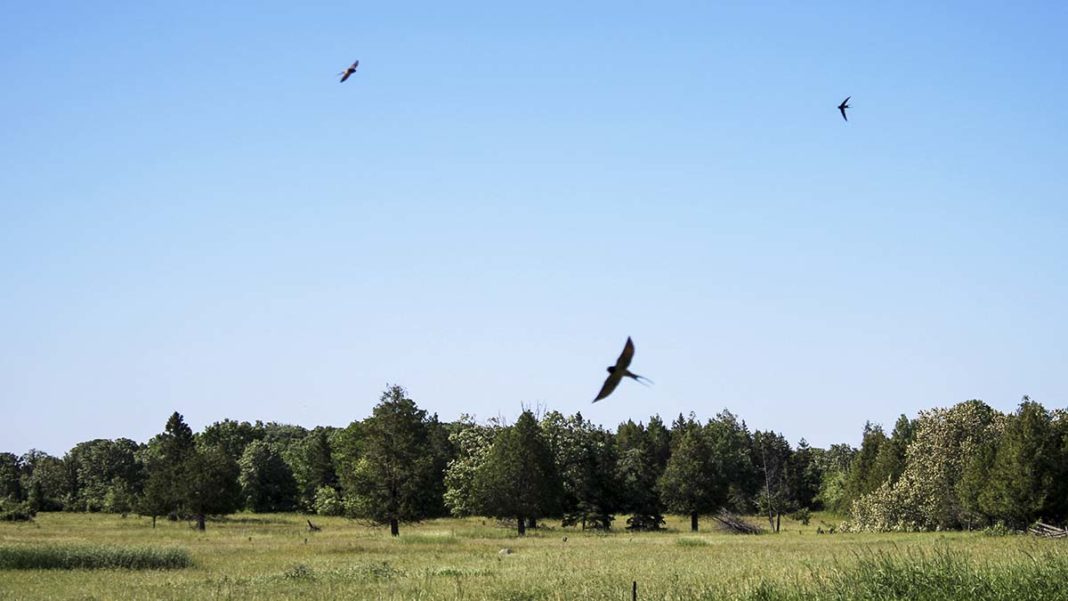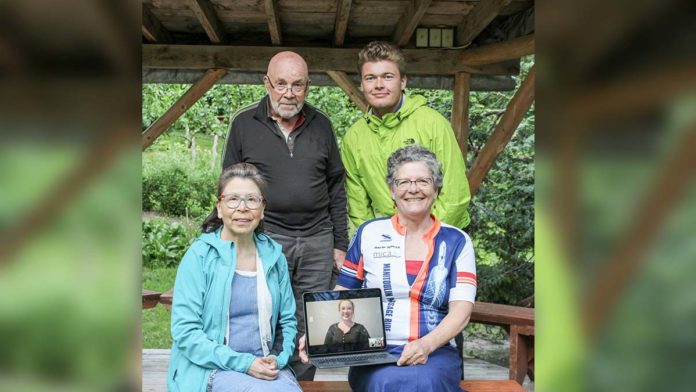by Maureen Strickland
MANITOULIN—A small bird chases a crow five times its size, dive-bombing and pecking, soaring over the June fields ripe for haying on the backroads of Ice Lake.
The small bird is a barn swallow. The back road is in a 10 by 10-kilometre area known as square 17TLL98. Square 17TLL98 is one of over two thousand squares in Ontario that will be surveyed extensively by volunteers for the Ontario Breeding Bird Atlas 3.
This is the third breeding bird atlas project in Ontario. The first was from 1981-1985. The breeding bird atlas work happens every 20 years and is a five-year study, fueled by volunteers. The current study started in 2021 and ends in 2025.
In 2019, the Cornell Lab of Ornithology analyzed all the breeding bird studies across North America and concluded that nearly 3 billion birds had vanished over the preceding 50 years.
“What would the world be like without birds,” ponders Anna Sheppard on a break at Grundy Lake Provincial Park where she is spending the weekend participating in a square-bash.
At a square-bash, birders get together at a base camp for four to five days and do point counts and general observations, or atlassing, in multiple squares.
A species can be determined by general observation, while the point counts help to determine how abundant they are.
The information gathered on breeding bird species and abundance is then added to the breeding bird database.
Ms. Sheppard is one of two volunteer regional coordinators for region 33, Manitoulin Island. The provincial breeding bird atlas is a massive undertaking. On Manitoulin Island alone, there are 77 individual squares.
From 2001 – 2005, for Ontario Breeding Bird Atlas 2, volunteers put in 150,000 hours of atlassing.
Volunteering for the atlas is a “canary in the coal mine” effort.
With climate change and biodiversity loss looming over the planet, most people are now familiar with the saying “canary in a coal mine”. The loss of a species, be it a bird, a fish, an animal, a plant or an insect, can be an indicator of significant problems with that species’ natural habitat.
Barn swallows are on the species-at-risk list in Canada. The Manitoulin Streams webpage shows them as threatened on Manitoulin Island.
Mike Cadman has coordinated Ontario Bird Breeding Atlas one, two and three. Mr. Cadman says the barn swallow showed big declines from the 1970s to 2008 in Canada but numbers are now stable across the country, and it is likely barn swallows will be moved to the species ‘of’ concern list.
In square 17TLL98, the barn swallow is one of 193 distinct breeding species expected to be found in the square during breeding season.
The breeding season is generally the last half of May to the end of June but it does vary by species.
Square 17TLL98 is diverse. It encompasses most of Ice Lake, the northern tip of Lake Kagawong and even nudges the eastern edge of Mudge Bay on the North Channel. There are lakes, swamps, shorelines, creeks, farmland, pasture, hardwood, softwood and mixed forest stands.
This square has not been claimed for atlas 3. To claim a square means to take responsibility for identifying breeding birds in that area.
Only a few entries can be spotted in the summary data for this square. Square data is accessible to anyone through the Ontario Breeding Bird Atlas 3 website.
Many squares have not been claimed on Manitoulin, says Ms. Sheppard, noting there is still lots of opportunity to get involved, even this year.
In terms of the province, “Manitoulin is such a unique environment so it’s an important piece of the puzzle that we don’t want left behind,” Ms. Sheppard adds.
John Diebolt is a key volunteer for the breeding bird atlas on the Island. He participated in atlas two and has claimed two squares east of Mindemoya and west of Sandfield.
Mr. Diebolt spends about four hours each week during the breeding season looking for birds in the two squares. He spends another two hours entering his observations into the breeding bird atlas webpage.
He is quick to note that anyone, anywhere, in Ontario can contribute to the breeding bird atlas by uploading their observations to the breeding bird atlas webpage.
In fact, most of the entries for the Ice Lake square are from birdwatching tourists travelling through, says Ms. Sheppard.
Ms. Sheppard encourages anyone on the Island who has local bird knowledge to participate in the atlas. Reporting a visual sighting of a bird building a nest or feeding its young on your property really boosts the data in the survey.
To protect their nests and young, barn swallows fight off crows and gulls and other predatory birds.
They are high energy birds that look a bit like a pair of scissors in flight.
Barn swallows are an important part of the Ice Lake ecosystem. They provide natural pest control, eating 60 insects per hour for a daily total of 850 insects.
Their abilities in natural pest control are believed to have led to the old farm superstition that if a swallow’s nest was damaged, cows would stop producing milk or chickens would stop laying eggs. Having a swallow nest on your property is considered lucky by many.
Barn swallows nest locally in the hundred-year-old barns of Ice Lake. This information is important to the atlas says Ms. Sheppard.
Besides the environmental imperative, Ms. Sheppard, Mr. Diebolt, Mr. Cadman and the hundreds of other volunteer bird watchers across the province participate in the breeding bird atlas because they love birds and find them fascinating.
Mr. Cadman says about his decades long commitment to the atlas, “it is the simplest way I can use my knowledge for science and conservation, “the data is immediately available to scientists.”
Data from volunteer citizen scientists helped identify the collapse of the bald eagle and other predatory bird populations in Ontario in the 1980s. Conservation efforts were taken to save these birds and data from the volunteer observations for atlas two confirmed the populations were bouncing back.
Early data from atlas three shows these species are thriving says Mr. Cadman.
There are many ways to get involved on Manitoulin in the breeding bird atlas, says Ms. Sheppard.
“If you have a car and you can drive, you can do it. If you have property and can make observations, you can do it.”
One of the easiest ways to get involved, said Ms. Sheppard, is to contact her and get set up with a recording device. “Press record and state your name, location and time and record bird sounds for five minutes,” says Ms. Sheppard.
The sound files are uploaded and a specialist skilled in identifying birds by ear will do the rest of the work.
These simple recordings can make a huge difference in filling in information gaps in the atlas.
The map of Ontario on the Ontario Breeding Bird Atlas website is overlaid with the 10 by 10-kilometre squares. The squares do not align with any roads or political boundaries.
Nature and birds, indeed all life on the planet, defies human-made boundaries.
The barn swallows make mud nests in the rafters of barns throughout Canada in the spring. In the fall, they fly thousands of kilometres to South America, then return again the next spring to breed.
Ms. Sheppard hopes the data from the breeding bird atlas will help us, as a society, make decisions to stop habitat loss and, indeed, facilitate habitat gain. Healthy habitat is essential for biodiversity.
She reflects on the idea of a shifting baseline and asks, “How many birds would I have heard 50 years ago, and how many birds will my children hear 50 years from now?”
If anyone is interested in getting involved in the breeding bird atlas on Manitoulin Island, please contact Anna Sheppard at manitoulin@birdsontario.org
To register or for more information on the Ontario Breeding Bird Atlas 3 go to www.birdsontario.org.




